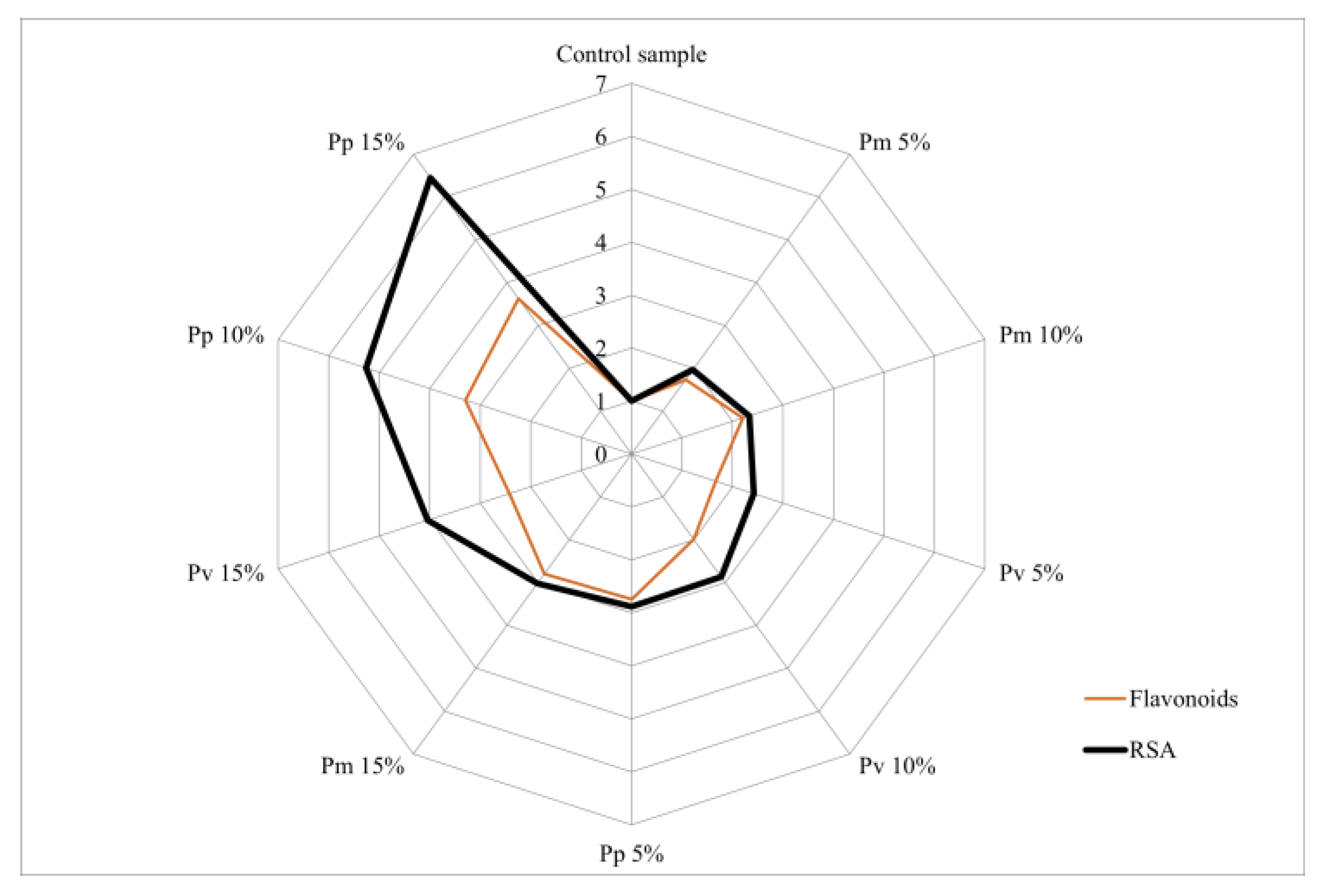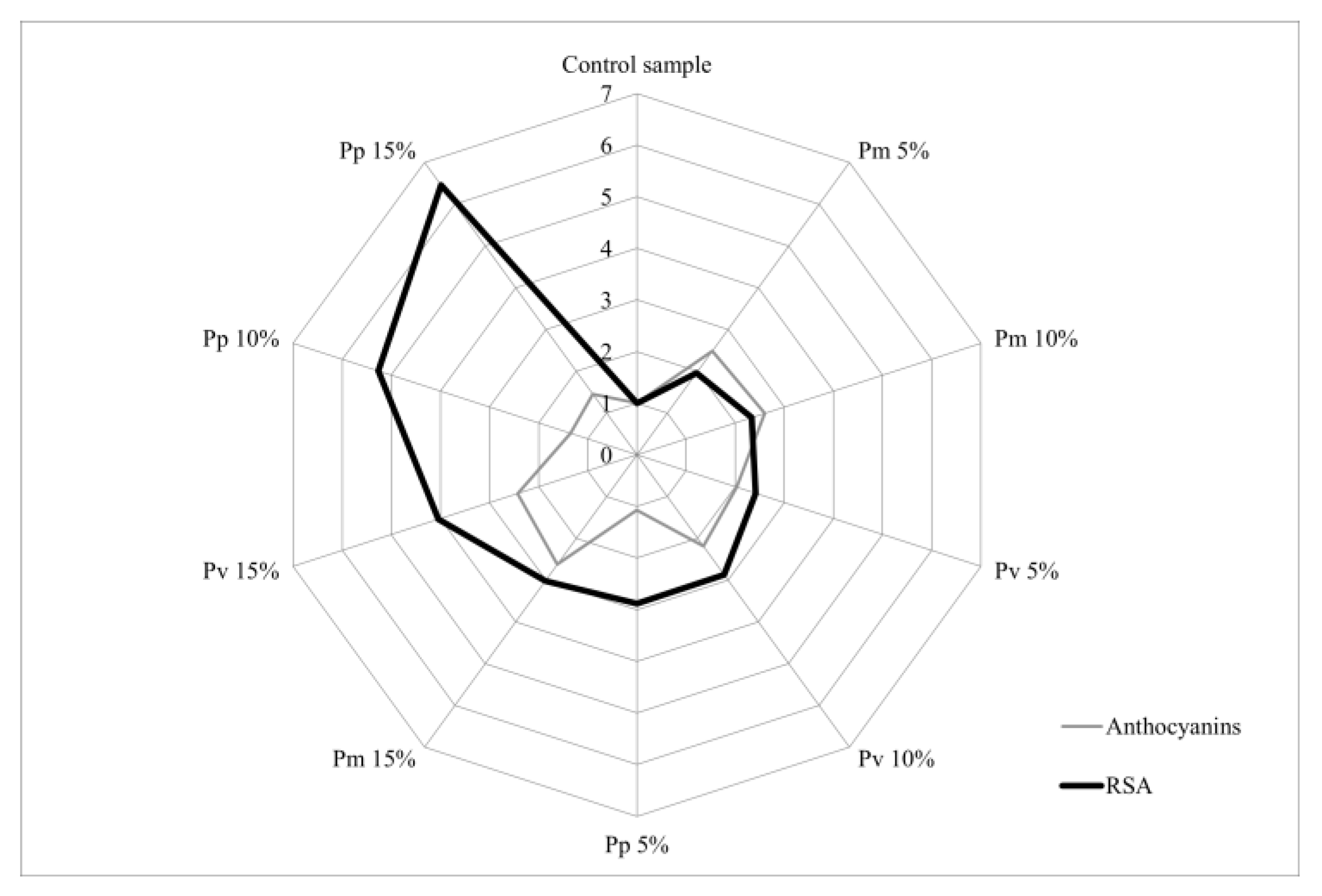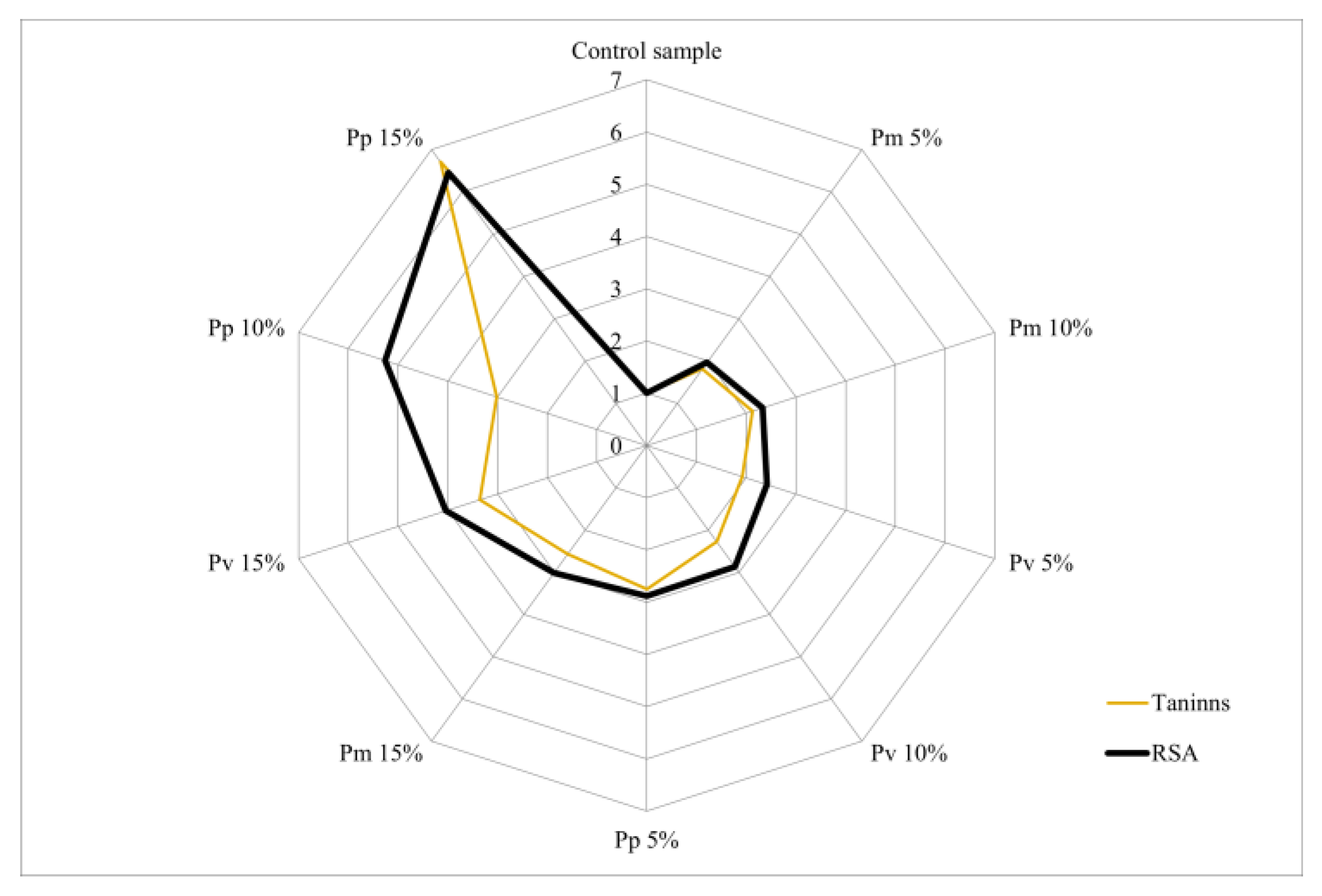Insight into Bioactive Compounds and Antioxidant Activity of Bakery Products Fortified with Fruit Pomace
Abstract
1. Introduction
2. Materials and Methods
2.1. Plant Material
2.2. Experimental Variants
2.3. Methods of Analysis
2.3.1. Preparation of Extracts Specific for the Quantification of Polyphenols, Flavonoids and Anthocyanins
2.3.2. Preparation of Extracts Specific for the Quantification of Tannins and Sugars
2.3.3. Determination of Total Polyphenol Content
2.3.4. Determination of Total Flavonoid Content
2.3.5. Determination of Total Anthocyanin Content
2.3.6. Determination of Total Tannin Content
2.3.7. Determination of Total Sugar Content
2.3.8. Determination of Components with Antiradical Potential
2.4. Statistical Analysis
3. Results and Discussion
4. Conclusions
Author Contributions
Funding
Data Availability Statement
Conflicts of Interest
Abbreviations
| PM | Bread with added apple pomace. |
| PV | Bread with added sour cherry pomace. |
| PP | Bread with added peach pomace. |
References
- Ameh, M.O.; Gernah, D.I.; Igbabul, B.D. Physico-Chemical and Sensory Evaluation of Wheat Bread Supplemented with Stabilized Undefatted Rice Bran. Food Nutr. Sci. 2013, 4, 43–48. [Google Scholar] [CrossRef]
- Kalinina, I.; Fatkullin, R.; Naumenko, N.; Popova, N.; Stepanova, D. The Influence of Flavonoid Dihydroquercetin on the Enzymatic Processes of Dough Ripening and the Antioxidant Properties of Bread. Fermentation 2023, 9, 263. [Google Scholar] [CrossRef]
- Zarzycki, P.; Wirkijowska, A.; Teterycz, D.; Łysakowska, P. Innovations in Wheat Bread: Using Food Industry By-Products for Better Quality and Nutrition. Appl. Sci. 2024, 14, 3976. [Google Scholar] [CrossRef]
- Tolve, R.; Simonato, B.; Rainero, G.; Bianchi, F.; Rizzi, C.; Cervini, M.; Giuberti, G. Wheat Bread Fortification by Grape Pomace Powder: Nutritional, Technological, Antioxidant, and Sensory Properties. Foods 2021, 10, 75. [Google Scholar] [CrossRef]
- Montealegre, P.R.; Peces, R.R.; Vozmediano, J.L.C.; Gascueña, J.M.; Romero, G. Phenolic compounds in skins and seeds of ten grape Vitis vinifera varieties grown in a warm climate. J. Food Comp. Anal. 2006, 19, 687–693. [Google Scholar] [CrossRef]
- Cao, H.; Ou, J.; Chen, L.; Zhang, Y.; Szkudelski, T.; Delmas, D.; Daglia, M.; Xiao, J. Dietary polyphenols and type 2 diabetes: Human Study and Clinical Trial. Crit. Rev. Food Sci. Nutr. 2019, 59, 3371–3379. [Google Scholar] [CrossRef]
- Rothwell, J.A.; Knaze, V.; Zamora-Ros, R. Polyphenols: Dietary assessment and role in the prevention of cancers. Curr. Opin. Clin. Nutr. Metab. Care 2017, 20, 512–521. [Google Scholar] [CrossRef]
- Iqbal, A.; Schulz, P.; Rizvi, S.S. Valorization of bioactive compounds in fruit pomace from agro-fruit industries: Present Insights and future challenges. Food Biosci. 2021, 44, 101384. [Google Scholar] [CrossRef]
- Lee, J.; Koo, N.; Min, D.B. Reactive oxygen species, aging, and antioxidative nutraceuticals. Compr. Rev. Food Sci. Food Saf. 2004, 3, 21–33. [Google Scholar] [CrossRef]
- Santini, A.; Novellino, E. Nutraceuticals: Shedding light on the grey area between pharmaceuticals and food. Expert Rev. Clin. Pharmacol. 2018, 11, 545–547. [Google Scholar] [CrossRef] [PubMed]
- Fu, J.J.; Sun, C.; Tan, Z.F.; Zhang, G.Y.; Chen, G.B.; Song, L. Nanocomplexes of curcumin and glycated bovine serum albumin: The formation mechanism and effect of glycation on their physicochemical properties. Food Chem. 2022, 368, 130651. [Google Scholar] [CrossRef]
- Pecyna, A.; Krzywicka, M.; Blicharz-Kania, A.; Buczaj, A.; Kobus, Z.; Zdybel, B.; Domin, M.; Siłuch, D. Impact of Incorporating Two Types of Dried Raspberry Pomace into Gluten-Free Bread on Its Nutritional and Antioxidant Characteristics. Appl. Sci. 2024, 14, 1561. [Google Scholar] [CrossRef]
- Cosmulescu, S.; Trandafir, I.; Nour, V.; Botu, M. Total phenolic, flavonoid distribution and antioxidant capacity in skin, pulp and fruit extracts of plum cultivars. J. Food Biochem. 2015, 39, 64–69. [Google Scholar] [CrossRef]
- Stamin, F.D.; Vijan, L.E.; Topală, C.M.; Cosmulescu, S.N. The Influence of Genotype, Environmental Factors, and Location on the Nutraceutical Profile of Rosa canina L. Fruits. Agronomy 2024, 14, 2847. [Google Scholar] [CrossRef]
- Cosmulescu, S.N.; Trandafir, I.; Cornescu, F. Antioxidant capacity, total phenols, total flavonoids and colour component of cornelian cherry (Cornus mas L.) wild genotypes. Not. Bot. Horti Agrobot. 2019, 47, 390–394. [Google Scholar] [CrossRef]
- El Anany, A.M. Nutritional composition, antinutritional factors, bioactive compounds and antioxidant activity of guava seeds (Psidium Myrtaceae) as affected by roasting processes. J. Food Sci. Technol. 2015, 52, 2175–2183. [Google Scholar] [CrossRef]
- Czubaszek, A.; Czaja, A.; Sokół-Łętowska, A.; Kolniak-Ostek, J.; Kucharska, A.Z. Changes in Antioxidant Properties and Amounts of Bioactive Compounds during Simulated In Vitro Digestion of Wheat Bread Enriched with Plant Extracts. Molecules 2021, 26, 6292. [Google Scholar] [CrossRef] [PubMed]
- Gumul, D.; Oracz, J.; Litwinek, D.; Żyżelewicz, D.; Zięba, T.; Sabat, R.; Wywrocka-Gurgul, A.; Ziobro, R. Quality- and Health-Promoting Compounds of Whole Wheat Bread with the Addition of Stale Bread, Cornmeal, and Apple Pomace. Foods 2024, 13, 1767. [Google Scholar] [CrossRef]
- Gumul, D.; Ziobro, R.; Korus, J.; Kruczek, M. Apple Pomace as a Source of Bioactive Polyphenol Compounds in Gluten-Free Breads. Antioxidants 2021, 10, 807. [Google Scholar] [CrossRef] [PubMed]
- Valková, V.; Ďúranová, H.; Havrlentová, M.; Ivanišová, E.; Mezey, J.; Tóthová, Z.; Gabríny, L.; Kačániová, M. Selected Physico-Chemical, Nutritional, Antioxidant and Sensory Properties of Wheat Bread Supplemented with Apple Pomace Powder as a By-Product from Juice Production. Plants 2022, 11, 1256. [Google Scholar] [CrossRef]
- Gumul, D.; Korus, J.; Ziobro, R.; Kruczek, M. Enrichment of Wheat Bread with Apple Pomace as a Way to Increase Pro-Health Constituents. Qual. Assur. Saf. Crops Foods 2019, 11, 231–240. [Google Scholar] [CrossRef]
- Amarowicz, R.; Carle, R.; Dongowski, G.; Durazzo, A.; Galensa, R.; Kammerer, D.; Maiani, G.; Piskula, M.K. Influence of postharvest processing and storage on the content of phenolic acids and flavonoids in foods. Mol. Nutr. Food Res. 2009, 53, S151–S183. [Google Scholar] [CrossRef]
- Gulcin, I. Antioxidants and antioxidant methods-An updated overview. Arch. Toxicol. 2020, 94, 651–715. [Google Scholar] [CrossRef]
- Smeriglio, A.; Barreca, D.; Bellocco, E.; Trombetta, D. Chemistry, Pharmacology and Health Benefits of Anthocyanins: Anthocyanins and Human Health. Phytother. Res. 2016, 30, 1265–1286. [Google Scholar] [CrossRef] [PubMed]
- Maicas, S. The Role of Yeasts in Fermentation Processes. Microorganisms 2020, 8, 1142. [Google Scholar] [CrossRef]
- Mir, S.A.; Bosco, S.J.D.; Shah, M.A.; Santhalakshmy, S.; Mir, M.M. Effect of Apple Pomace on Quality Characteristics of Brown Rice Based Cracker. J. Saudi Soc. Agric. Sci. 2017, 16, 25–32. [Google Scholar] [CrossRef]
- Cantero, L.; Salmerón, J.; Miranda, J.; Larretxi, I.; Fernández-Gil, M.d.P.; Bustamante, M.Á.; Matias, S.; Navarro, V.; Simón, E.; Martínez, O. Performance of Apple Pomace for Gluten-Free Bread Manufacture: Effect on Physicochemical Characteristics and Nutritional Value. Appl. Sci. 2022, 12, 5934. [Google Scholar] [CrossRef]
- Zaky, A.A.; Witrowa-Rajchert, D.; Nowacka, M. Turning Apple Pomace into Value: Sustainable Recycling in Food Production—A Narrative Review. Sustainability 2024, 16, 7001. [Google Scholar] [CrossRef]




| Raw and Auxiliary Materials | Control Bread | Bread with Pomace (Pm, Pv, Pp) 5% | Bread with Pomace (Pm, Pv, Pp) 10% | Bread with Pomace (Pm, Pv, Pp) 15% |
|---|---|---|---|---|
| Wheat flour | 250 g | 237.5 g | 225 g | 212.5 g |
| Apple pomace powder | 0 | 12.5 g | 25 g | 37.5 g |
| Sour cherry pomace powder | 0 | 12.5 g | 25 g | 37.5 g |
| Peach pomace powder | 0 | 12.5 | 25 g | 37.5 g |
| Yeast | 4 g | 4 g | 4 g | 4 g |
| Water | 150 mL | 150 mL | 150 mL | 150 mL |
| Salt | 4 g | 4 g | 4 g | 4 g |
| Sample | Concentration | Polyphenols (mg GAE/100 g) | Flavonoids (mg CE/100 g) | Anthocyanins (mg C3G/100 g) |
|---|---|---|---|---|
| Control sample | 0% | 349.54 ± 0.77 j | 49.87 ± 1.27 j | 6.15 ± 0.08 i |
| Bread with added apple pomace (Pm) | 5% | 479.42 ± 0.73 i | 86.68 ± 1.30 h | 15.26 ± 0.06 b |
| 10% | 613.15 ± 1.43 e | 110.09 ± 1.48 f | 16.03 ± 0.06 a | |
| 15% | 799.53 ± 2.91 b | 139.61 ± 1.25 c | 16.12 ± 0.03 a | |
| Bread with added sour cherry pomace (Pv) | 5% | 482.86 ± 0.43 h | 82.99 ± 1.21 i | 12.48 ± 0.09 e |
| 10% | 558.26 ± 0.86 f | 99.28 ± 1.50 g | 13.46 ± 0.07 d | |
| 15% | 629.78 ± 1.01 d | 120.45 ± 1.72 e | 14.95 ± 0.06 c | |
| Bread with added peach pomace (Pp) | 5% | 549.99 ± 0.54 g | 136.83 ± 1.94 d | 6.59 ± 0.06 h |
| 10% | 732.91 ± 2.43 c | 164.39 ± 2.07 b | 8.31 ± 0.08 g | |
| 15% | 855.10 ± 3.04 a | 181.01 ± 0.54 a | 8.92 ± 0.08 f |
| Sample | Concentration | Tannins (mg GAE/100 g) | Sugars (g GluE/100 g) | RSA (%) |
|---|---|---|---|---|
| Control sample | 0% | 57.44 ± 1.14 j | 7.28 ± 0.12 h | 6.64 ± 0.55 g |
| Bread with added apple pomace (Pm) | 5% | 103.96 ± 1.35 i | 27.48 ± 0.30 b | 13.03 ± 0.91 f |
| 10% | 122.10 ± 1.43 g | 27.82 ± 0.29 b | 15.49 ± 0.56 e | |
| 15% | 147.77 ± 1.76 e | 28.67 ± 0.41 a | 20.04 ± 0.70 d | |
| Bread with added sour cherry pomace (Pv) | 5% | 110.11 ± 0.31 h | 19.06 ± 0.14 e | 16.05 ± 0.48 e |
| 10% | 130.83 ± 1.11 f | 22.09 ± 0.17 d | 19.04 ± 0.55 d | |
| 15% | 192.82 ± 2.19 b | 23.18 ± 0.25 c | 26.83 ± 0.89 c | |
| Bread with added peach pomace (Pp) | 5% | 157.84 ± 1.03 d | 10.42 ± 0.12 g | 19.13 ± 0.66 d |
| 10% | 173.04 ± 0.80 c | 10.69 ± 0.24 g | 34.95 ± 0.57 b | |
| 15% | 385.26 ± 1.75 a | 11.27 ± 0.39 f | 42.84 ± 0.56 a |
Disclaimer/Publisher’s Note: The statements, opinions and data contained in all publications are solely those of the individual author(s) and contributor(s) and not of MDPI and/or the editor(s). MDPI and/or the editor(s) disclaim responsibility for any injury to people or property resulting from any ideas, methods, instructions or products referred to in the content. |
© 2025 by the authors. Licensee MDPI, Basel, Switzerland. This article is an open access article distributed under the terms and conditions of the Creative Commons Attribution (CC BY) license (https://creativecommons.org/licenses/by/4.0/).
Share and Cite
Mandache, M.B.; Vijan, L.E.; Cosmulescu, S. Insight into Bioactive Compounds and Antioxidant Activity of Bakery Products Fortified with Fruit Pomace. Foods 2025, 14, 806. https://doi.org/10.3390/foods14050806
Mandache MB, Vijan LE, Cosmulescu S. Insight into Bioactive Compounds and Antioxidant Activity of Bakery Products Fortified with Fruit Pomace. Foods. 2025; 14(5):806. https://doi.org/10.3390/foods14050806
Chicago/Turabian StyleMandache, Maria Bianca, Loredana Elena Vijan, and Sina Cosmulescu. 2025. "Insight into Bioactive Compounds and Antioxidant Activity of Bakery Products Fortified with Fruit Pomace" Foods 14, no. 5: 806. https://doi.org/10.3390/foods14050806
APA StyleMandache, M. B., Vijan, L. E., & Cosmulescu, S. (2025). Insight into Bioactive Compounds and Antioxidant Activity of Bakery Products Fortified with Fruit Pomace. Foods, 14(5), 806. https://doi.org/10.3390/foods14050806






